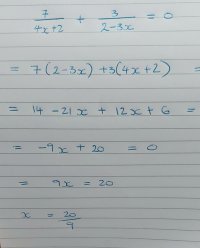hey just need to know if im on the right track with this: 7/(4x+2) + 3/(2 - 3x) = 0
- Thread starter MrBubbles
- Start date
- Joined
- Feb 4, 2004
- Messages
- 16,582
so im to solve, and state assumptions on x.View attachment 37039
i am i on the correct track?
You can check the answer to any "solving" exercise by plugging your value back into the original problem. If your case, you want to see if x=920 makes the original equation true. So check, plugging into the left-hand side:
4(920)+27+2−3(920)3
(998)7+(9−42)3
(17)(989)+(13)(−429)
149−149
0
So the solution checks.
so im to solve, and state assumptions on x.
i am i on the correct track?
suki, you are certainly on the right track, with a correct final solution,
and you were shown how your solution checks. Let me write a slight
redo with certain equals signs that do not belong. Also, let me
address the "assumptions on x" you mentioned.
4x+27 + 2−3x3 = 0
7(2−3x) + 3(4x+2) = 0
14−21x+12x+6 = 0
−9x+20 = 0
9x = 20
x = 920
-------------------------------------------------------------------------------------------------------------
For the fractions in the first line, neither denominator may equal zero.
We can find out restrictions on x by stating each denominator is not
equal to zero and solve that respective nonequation:
4x+2=0
4x=−2
x=2−1
Also,
2−3x=0
−3x=−2
x=32
---------------------------------------------------------------------------------------
Notice how the solution of x = 920 is different from either of
these two restricted values.

